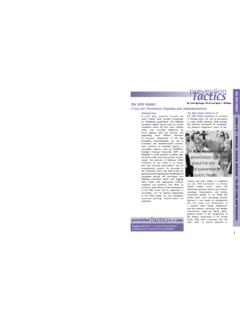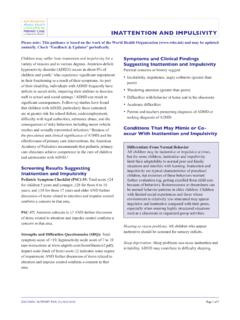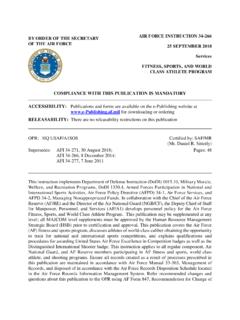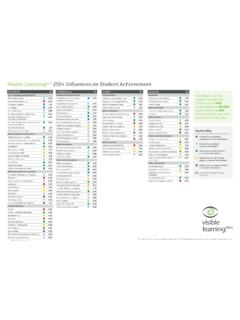Transcription of Preventing Substance Abuse in Military Members and Their ...
1 Prevention Tactics Preventing Substance Abuse in Military Members and Their families By Gregory Leskin, PhD. Preventing Substance Abuse in Military Members and Their families Military service Members sent to war oftentimes face life-threatening conditions in which they must survive in some of the most dangerous environments and conflictual circumstances. These experiences include armed combat, witnessing the death of others, as well as experiencing daily, even constant, threats of injury or death. The Military family back home may experience strain due to separation as well as distress and worry about the service member's safety during a combat deployment.
2 For a Military family member, the absence of a parent or sibling might increase the possibility of alcohol, tobacco, and other drug (ATOD) Abuse (Gilreath et al., 2013). From 2003 to 2013, the US Military was involved in multiple, large-scale deployments, including that stress the importance of wellness, resiliency, extended and repeated tours of duty to Iraq and protective factors for Military Members and and Afghanistan. As a result of these combat Their families at risk for Substance Abuse will also deployments, thousands of service Members have be presented (Luthar, 2006). Promotion of these died or been injured on the battlefield.
3 An even factors elicits connection to concrete support greater number of service Members and veterans during times of need, including social connections suffer from physical injuries and psychological as well as skills and knowledge about ways to resist disorders such as Post-Traumatic Stress Disorder Substance Abuse . Programs that target youth from (PTSD). The traumatic experiences of the Military Military families ensure that the youth are sufficiently member often affect Their family as well. Recent supported and connected to positive peer programs research suggests that families of National Guard and caring professionals, especially during difficult Members who suffer from PTSD may experience transitions and family separations.
4 In the following difficulties providing adequate positive parenting sections, the Tactic outlines the scope of Substance and supportive communication to Their children Abuse problems in Military settings for service (Gewirtz & Davis, 2014). Members and Their families , and recommends some evidence-based prevention programs and policies. The focus of this prevention tactic is to examine the challenges that Military Members and Their families Scope of the Problem: Service Members experience that may result in an increased risk for Substance Abuse . The Tactic will also highlight best Members of the armed forces and Their families have practices, prevention programs, and resources that historically suffered with Substance Abuse problems, specialize in serving Military Members and Their including difficulties with alcohol, tobacco, and families .
5 Effective prevention programs and policies other drugs. Recent data suggests lower illicit drug use within the Military when compared to the rest of society. However, there are indications of heavier preventionTactics 9:14 (2015) alcohol, tobacco, and prescription drug use. Among 88,205 service member respondents of the 2008. Tactics (Tak'tiks) n. 1. a plan for promoting Department of Defense Health Behavior Survey a desired end. 2. the art of the possible. who recently deployed to Iraq, 12% to 15% of the respondents reported experiencing difficulties with drinking excessive alcohol (Bray et al.)
6 , 2010). This rate other Military -related activities. Heavy drinking and represents roughly double the 7% incidence of alcohol addiction to pain medications appear to be linked to use disorders among adults in the US estimated by mental health issues including post-traumatic stress, the Substance Abuse and Mental Health Services adjustment disorders, anxiety, depressive disorders, Administration (SAMHSA, 2013). In an analysis of and suicidal ideation and attempts. psychiatric data from the 2005 Survey of Health Care Experiences (SHEP) administered by the Veterans Scope of the Problem: Military families Health Administration, 36% of National Guard and Reserve Members serving in Iraq or Afghanistan were There is growing literature to suggest that Military determined to be at risk for the misuse of alcohol after families can also be negatively impacted by the returning from deployment (Burnett-Zeigler et al.
7 , stressors associated with Military life, especially the 2011). frequent transitions and separations associated with Military life and combat deployment (Van Winkle and Alcohol and Other Drug Use Lipari, 2013). Research suggests that most Military and Abuse Among Service Members spouses and youth are resilient and adapt well to Military lifestyle demands, especially those family In the 2008 Department of Defense (DoD) Members who have strong support systems. However, Survey of Health Related Behaviors Among Active Military families may experience challenges which Duty Military Personnel, the estimated prevalence may expose them to risk for behavioral health issues, rate among active duty service Members actively including Substance Abuse .
8 For example, a Military using illicit drugs was 12%, prescription drug youth may experience difficulties adjusting to the misuse was 11%, heavy alcohol use was 20%, and absence of Their deployed parent. This challenge may tobacco, including smokeless, was 31% (Bray et al., be influenced by a number of factors including the 2010). number of deployments, the length of deployment, and parental distress (Lester et al., 2010). Sixty-eight In the 2004 Land Combat Study, the number of percent of Military service Members report that Their soldiers and Marines who responded positively child experienced separation anxiety associated with to a survey question that asked Have you used Their deployment and 63% reported that Their child more alcohol than you meant to?
9 Increased from experienced ongoing worries and fears associated 17% before deployment to 24-35% after overseas with the parent's involvement in combat situations combat deployment to Iraq or Afghanistan (Chandra et al., 2011). Military youth who experience (Hoge et al., 2004). the death or injury of a Military parent are at a higher The Millennium Cohort Study surveyed Military risk for mental health and Substance Abuse disorders. Members returning from combat deployment and found that these Military Members engaged in binge drinking at a rate of 54% with new onset rate of alcohol use at 26% (Jacobson et al.)
10 2008). Military deployments are associated with higher rates of tobacco initiation and recidivism, especially among those troops with extended or multiple deployments (Smith et al., 2008). An important recent trend among service Members is use and addiction to prescription medications. In 2009, Military doctors ordered about million prescriptions for pain medications (Zoroya, 2010), which is approximately four times the number of prescriptions written before Military deployment in 2001. These prescriptions are written to address medical issues related to injuries suffered during combat and 2. Emotional problems experienced by Military families et al.








